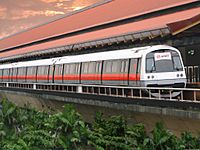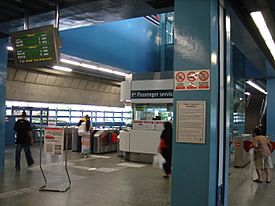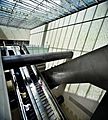Mass Rapid Transit (Singapore) facts for kids
Quick facts for kids Mass Rapid Transit (MRT)大众捷运系统 (地铁) Sistem Pengangkutan Gerak Cepat துரிதக் கடவு ரயில் |
|
|---|---|
 |
|
| Info | |
| Owner | Land Transport Authority |
| Locale | Singapore |
| Transit type | Rapid transit |
| Number of lines | 5 |
| Number of stations | 154 (102 in operation, 52 under construction or planning) |
| Daily ridership | 2.879 million (2015) |
| Operation | |
| Began operation | 7 November 1987 |
| Operator(s) |
|
| Technical | |
| System length | 118.9 km (73.9 mi) |
The Mass Rapid Transit or MRT (Chinese: 大众快速交通 or more commonly known as 地铁; Malay: Sistem Pengangkutan Gerak Cepat; Tamil: சிங்கை துரிதக் கடவு ரயில்) is a rapid transit system in Singapore.
It is a rapid transit system which links the different places of Singapore together using a network, or different connections of trains. When a person travels from one place to another, he or she boards a train in a train station and then the train moves until the train reaches the place he or she wants to come out, or alight. Sometimes he or she has to change trains.
About 2.879 million passengers use the MRT. The system is 170.7 km long and has 106 stations. The trains run from 5:30 am to 1:00 am every day except for the festive periods, such as Christmas Eve, New Year's Eve and Chinese New Year's Eve. A train comes every 2–3 minutes in peak hours, every 7 minutes during off-peak hours and 5–6 minutes for the weekend service. It is operated by the Singapore's SMRT Corporation and SBS Transit.
There are currently 5 lines in the MRT system, where they are connected by special stops called interchanges. The lines are North South Line, East West Line, North East Line, Circle Line and Downtown Line. The Circle Line opened in four stages from 28 May 2009 to 14 January 2012. Stage 1 of Downtown Line opened on 22 December 2013 with its official opening made on 21 December 2013 by Prime Minister Lee Hsien Loong.
On December 16, 2011 the MRT network suffered what is likely to be the worst breakdown in its 24-year operating history. 'A power rail problem' made North-South Line trains suddenly lost power and ground halt in darkness and without ventilation for up to an hour accompanied only by light from mobile phones.
Contents
Network
| Line | First part opened | Stations | Length (km) |
Terminals | Depot along line | |
|---|---|---|---|---|---|---|
| North South Line (SMRT Trains) | 7 November 1987 | 26 | 45 | Jurong East | Marina Bay MRT Station Marina South Pier |
Bishan |
| East West Line (SMRT Trains) | 12 December 1987 | 35 | 57.2 | Pasir Ris | Joo Koon | Ulu Pandan Changi |
| 10 January 2001 | 3 | Tanah Merah | Changi Airport | |||
| North East Line (SBS Transit) | 20 June 2003 | 16 | 20 | HarbourFront | Punggol | Sengkang |
| Circle Line (SMRT Trains) | 28 May 2009 | 31 (1 not in operation) | 35.7 | Dhoby Ghaut | HarbourFront Marina Bay |
Kim Chuan |
| Downtown Line (SBS Transit) | 22 December 2013 | 36 (17 not in operation) | 42 | Bukit Panjang | Chinatown | Kim Chuan Gali Batu |
Openings
- 7 November 1987: Yio Chu Kang - Toa Payoh
- 12 December 1987: Toa Payoh - Outram Park
- 12 March 1988: Outram Park - Clementi
- 5 November 1988: Clementi - Lakeside
- 20 December 1988: Yio Chu Kang - Yishun
- 4 November 1989: Marina Bay - Tanah Merah
- 16 December 1989: Tanah Merah - Pasir Ris
- 10 March 1990: Jurong East - Choa Chu Kang
- 6 July 1990: Lakeside - Boon Lay
- 10 February 1996: Yishun - Choa Chu Kang
- 10 January 2001: Tanah Merah - Expo
- 18 October 2001: Dover
- 8 February 2002: Expo - Changi Airport
- 20 June 2003: HarbourFront - Punggol
- 28 February 2009: Boon Lay - Joo Koon
- 28 May 2009: Bartley - Marymount
- 17 April 2010: Bartley - Dhoby Ghaut
- 8 October 2011: Marymount - HarbourFront
- 14 January 2012: Promenade - Marina Bay
- 22 December 2013: Bugis - Chinatown
- 23 November 2014: Marina Bay - Marina South Pier
- 27 December 2015: Bukit Panjang - Bugis
Expansion
The MRT system had been using its two main lines, the North South and East West Lines, for more than ten years until the opening of the North East Line in 2003. While plans for these lines, as well as those being built, were made long before, the Land Transport Authority's (LTA) publication of a white paper entitled "A World Class Land Transport System" in 1996 showed the government's intentions to greatly expand on the existing system. The plans allow for the long-term replacement of the bus network by rail-based transportation as the main way of public transportation. It called for the expansion of the 67 kilometres of track in 1995 to over 160 in 10 to 15 years, and expected further expansion in the longer term. It was anticipated that daily ridership in 2020 would have grown to 4.6 million from the current 1.4 million passengers. By 2020, the density of the rail network will increase by 60 per cent, from 31 to 51 km per million population, comparable to cities like New York and London, and surpassing Hong Kong and Tokyo.
Downtown Line
The Downtown Line is being built now in three parts. The first part to open will be 4.3 kilometres with six stations connecting Bugis on the East West Line to Chinatown on the North East Line. The second part will connect Bukit Panjang in western Singapore with the first part. The third part will connect Expo in eastern Singapore with the first part. The parts will open in 2013, 2016, and 2017. It will be 40 kilometers long and have 33 stations. Stage 2 & 3 are in the construction phase. Stage 1 from Bugis to Chinatown began operations in December 2013.
Thomson-East Coast Line
The 30-kilometre Thomson-East Coast Line is planned to be completed by 2021 and consists of 22 stations. It will connect to the North South Line at Woodlands station, to the Circle Line at Thomson station, to the Downtown Line at Stevens station, to the North South Line at Orchard Road station, to the East West and Northeast lines at Outram Park station, and to the North South and Circle lines at Marina Bay station.
The 12-kilometre Eastern Region Line is tentatively planned to serve 10 stations. It will run from Marina Bay, passing through Tanjong Rhu, Siglap, Marine Parade and Bedok before terminating at Changi. The route is generally parallel to and located south of the East West Line. The line is currently under detailed engineering studies and is expected to open in 2020.
On 15 August 2014, they announced that both Thomson and Eastern Region Lines were being merged into Thomson-East Coast Line in TEL and making into 31 stations. And it will be opened by 2024.
Jurong Region Line
First proposed as a LRT line when originally announced in 2001, Jurong Region Line has been upgraded to a medium capacity line. The new configuration will serve West Coast, Tengah and Choa Chu Kang and Jurong. It's expected to open in 2025.
Cross Island Line
The 50-kilometre Cross Island Line will span the island of Singapore, passing through Tuas, Jurong, Sin Ming, Ang Mo Kio, Hougang, Punggol, Pasir Ris and Changi. The addition of the new line brings commuters with another alternative for East-West travel to the current East West Line. It will also connect to all the other major lines to serve as a key transfer line, complementing the role currently fulfilled by the orbital Circle Line. It's expected to open in 2030.
North South Line Extension
A 1-kilometre one station extension from Marina Bay initially due for completion in 2015, but brought forward by a year to 2014. The new Marina South Pier will be located near the Marina Bay Cruise Centre Singapore in Marina Bay. It was opened on 23 November 2014.
Tuas West Extension
The Tuas West Extension is an extension of the East West Line from Joo Koon to Tuas Link. The stations — Gul Circle, Tuas Crescent, Tuas West Road and Tuas Link — will extend MRT connectivity to the Tuas area and are expected to serve more than 100,000 commuters daily. It's expected to open in 2016. Construction began in 2012 and is planned to be completed in 2016.
Circle Line Stage 6
To be completed by 2025, the 4-kilometre extension will run from Marina Bay through Keppel, ending at HarbourFront.
Downtown Line Extension
To be completed by 2024, the extension will run from Expo and through Sungei Bedok area.
North East Line Extension
To be completed by 2030, the 2-kilometre extension will run from Punggol through Punggol North including the new Punggol Downtown. The extension is for future residents in Punggol North to have train access to the city centre as well as other parts of Singapore.
Facilities at the stations
Every station has at least 4 ticket machines, restrooms (toilets), a passenger service center, which controls what is happening in the train station and has wired radio with the train operator, payphones (public phones) and access for disabled. Some of them have automated teller machines, kiosks and a bus interchange nearby.
All stations in Singapore are either elevated or underground, and they are not surfaced. Underground stations and trains are air-conditioned. Elevated stations have half-height platform screen doors.
Rolling Stock
Three types of the rolling stock are used on the East West and North South Lines. Except for C751A, C830 and C951, the rest are powered by 750V DC and operate in 6-cars for North East Line while 3-cars for Circle Line and Downtown Line.
There are 66 trainsets which is made up of C151, built in 1986-89 by Kawasaki Heavy Industries and collaborating with three sub-companies, Kinki Sharyo, Nippon Sharyo and Tokyu Car Corp. It is the oldest trains in operation, being refurbished in 2008. 19 more C651s were purchased in 1994 from Siemens AG, followed by 21 more C751B sets, built in 1999-2000 from Kawasaki Heavy Industries and Nippon Sharyo.
25 six-car trainsets, overhead rail of C751A were built from 1999 to 2002 by Alstom, which has the model called Alstom Metropolis, used as North East Line. Another 40 three-car trainsets, Alstom Metropolis C830 the third-rail were built from 2005 to 2008, and were used as Circle Line.
For Downtown Line, it paid 73 three car Bombardier Movia C951 and was first delivery in 2012, later it paid another 15 C951s and making to 88 three cars by 2016.
In 2012, they have announced to further order of 24 C830C three-car set for Circle Line and 18 C751C six car sets for North East Line. C830Cs started on 26 June 2015 while C751C started on 1 October 2015. All C830Cs were on service.
For the Thomson-East Coast Line, the train, CT251 had paid 91 four-car set and started delivery between 2018 and 2021 and will start in 2019.
In 2012, they paid a total of 28 Kawasaki Heavy Industries & CSR Qingdao Sifang C151B trains for better improvement on North South Line and East West Line and was to start in 2016, in 2014 they paid another 29 trains making to 57 trains for C151B. On 21 May 2015, the C151B was first delivered and the remaining 12 were being paid Kawasaki Heavy Industries & CSR Qingdao Sifang C151C and was to construct between 2017 and 2019.
Fares and ticketing
Stations are divided into two areas, paid and unpaid, which allow the rail operators to collect fares by restricting entry only through the fare gates, also known as access control gates. These gates, connected to a computer network, are capable of reading and updating electronic tickets capable of storing data, and can store information such as the initial and destination stations and the duration for each trip. General Ticketing Machines sell tickets for single trips or allow the customer to purchase additional value for stored-value tickets. Tickets for single trips, coloured in green, are valid only on the day of purchase, and have a time allowance of 30 minutes beyond the estimated travelling time. Tickets that can be used repeatedly until their expiry date require a minimum amount of stored credit.
As the fare system has been integrated by TransitLink, commuters need to pay only one fare and pass through two fare gates (once on entry, once on exit) for an entire journey, even when transferring between lines operated by different companies. Commuters can choose to extend a trip mid-journey, and pay the difference as they exit their destination station.
The ticketing system uses the EZ-Link and NETS FlashPay contactless smart cards based upon the System for e-Payments (SeP) system for public transit built on the Singapore Standard for Contactless ePurse Application (CEPAS) system. This system allows for up to 4 card issuers in the market. The EZ-Link card was introduced on 13 April 2002 as a replacement to the original TransitLink farecard while its competitor the NETS FlashPay card entered the smart card market on 9 October 2009. The adult EZ-link card is at S$15 while the NETS FlashPay card is at S$13.
Safety
Assurance has been given by both operators and authorities, that numerous measures have been taken in an effort to ensure the safety of passengers, with SBS Transit having to make greater efforts in actively publicising its safety considerations on the driver-less North East Line before and after its opening. Safety campaign posters are highly visible in trains and stations, and the operators frequently broadcast safety announcements to passengers and to commuters waiting for trains. Fire safety standards are consistent with the strict guidelines of the US National Fire Protection Association. Platform screen doors are installed at all underground stations, with half-height platform screen doors currently being built at all aboveground stations, with some at Pasir Ris, Woodlands and Yishun. These doors prevent unauthorised access to restricted areas, as well as enable climate control in stations. Above-ground stations have open platforms, with a wide yellow line drawn 70 cm from each platform edge requiring passengers to stand at a safe distance from arriving trains (or face a fine). Bylaws deter uncivil, disruptive and dangerous acts, such as smoking, the consumption of food and drink, the frivolous use of safety features, and trespassing on the railway tracks. Penalties ranging from fines to imprisonment are imposed for these offences.
Safety concerns were raised among the public after several accidents on the system during the 1980s and 1990s, but most problems have been rectified. On 5 August 1993, two trains collided at Clementi MRT Station because of an oil spillage on the track, which resulted in 132 injuries. There were calls for platform screen doors to be installed at above-ground stations after several incidents in which passengers were killed by oncoming trains when they fell onto the railway tracks at above-ground stations. The authorities initially rejected the proposal by casting doubts over functionality and concerns about the high installation costs, but made an about-turn when the government announced plans to install half-height automatic platform gates in a speech on 25 January 2008, citing lower costs due to it becoming a more common feature worldwide.
Security
Security concerns related to crime and terrorism were not high on the agenda of the system's planners at its original inception. However, in the wake of heightened security concerns after the Madrid train bombings in 2004 and the foiled plot to bomb the Yishun MRT Station, the operators deployed private, unarmed guards to patrol station platforms and check the belongings of commuters.
Recorded announcements are frequently made to remind passengers to report suspicious activity and not to leave their belongings unattended. Digital closed-circuit cameras (CCTVs) have been upgraded with recording-capability at all stations and trains operated by SMRT Corporation. Trash bins and mail boxes have been removed from station platforms and concourse levels to station entrances. This is to eliminate the risk that bombs will be placed in them. Photography without prior permission was also banned in all MRT stations since.
On 14 April 2005, the Singapore Police Force announced plans to step up rail security by establishing a specialised Police MRT Unit, now known as Public Transport Security Command (Transcom). These armed officers began patrols on the MRT and LRT systems on 15 August 2005, conducting random patrols in pairs in and around rail stations and within trains. They are trained and authorised to use their firearms at their discretion, including deadly force if deemed necessary.
Images for kids
-
Canberra station, an infill station of the North South line
-
A Dynamic Route Map Display on the North East Line equipped on the C751A train
-
Expo MRT station, situated adjacent to the Singapore Expo exhibition facility, sports a futuristic design by Foster and Partners.
-
Bras Basah station has a water feature to allow sunlight from above the station to filter in.
-
Various types of General Ticketing Machines (GTM) at Bright Hill MRT station, where passengers can purchase a Standard Ticket or add value to their EZ-Link card
-
Cubic ticket barriers at Woodlands North station, one type of the many access control gates in the MRT system.
-
Closed-circuit television cameras monitor activities at City Hall station. A real-time video feed is broadcast and shown at the station concourse.
-
Airport scanners and security seen at Tampines MRT station.
See also
 In Spanish: Metro de Singapur para niños
In Spanish: Metro de Singapur para niños















